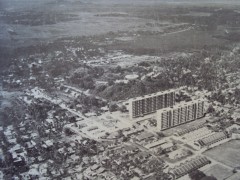Pre-Industrial Occupational Preferences
Image show yesteryears Ujong Pasir from Garden City
They had seen the buying of meat once bi-weekly, with a twenty cents, accompanied by a coupon. Malacca, the word, signify ' a meeting ' when equated with the arabic word, mulaqah.
In the past, men were busy in the small town, Chin Chin and Kesang, extracting tin ores. They had paid, 7 cents for a cup of kopi-o (black coffee), and half a decade later, they paid for the same cup, at Ten Dollars. (this was something like, 7 decades ago).
Then, hawker would earn about 60 dollars a month while rubber tapper took home 40 cents each day. That was the income or another frequently used local word, gaji. According to one elder, the word, gaji, derived from a Dutch word, gagie.
Several elders regularly visited, would reminisce ; ... we grew tapioca ... farming, a hard work. Human manure ladled on plants with coconut shell attached to a stick as handle ... . Perhaps, some of us; could remember, the bucket system, each day before dawn; the aroma would fill the air when we got up to prepare ourselves to schools.
Now, we are parents. The parents before us, would understand better the true enjoyment of 7 cents black coffee, and years later, the mushrooming of Taman Sinn, Ujong Pasir. The year, 1965, was significant; first, Singapore was seperated from Malaysia and secondly, the Ujong Pasir Hilir Garden Residents' Association, Malacca, was formed.
When Taman Sinn through 7 phases was completed in 1976, the garden provided 140 units of one-storey terrace houses and 60 units of semi-detached double storey houses over an area of 20 acres. Then, the mean household size of Hilir Garden was 6.21.
The parents before us, who dwelled, in the pre-industrial occupational preferences and who had once enjoyed eating tapioca with a 7 cents cup of black coffee, have manifested their growth through many ' windows ' today, with their childrens in new occupational preferences with the present era of creative and innovative incomes.
They had invested in our education.
Today, Ujong Pasir skyline looks like this ;
 |
| photo source http://raymond1188.blogspot.com/ |


Comments